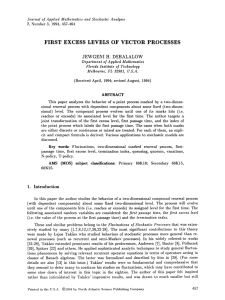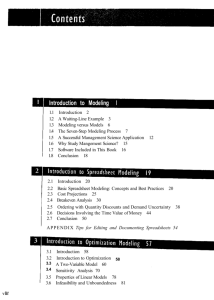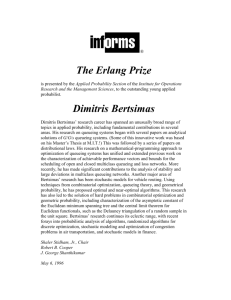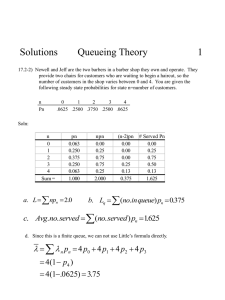TtIE LEVEL MULTI- DELAYED RENEWAL
advertisement
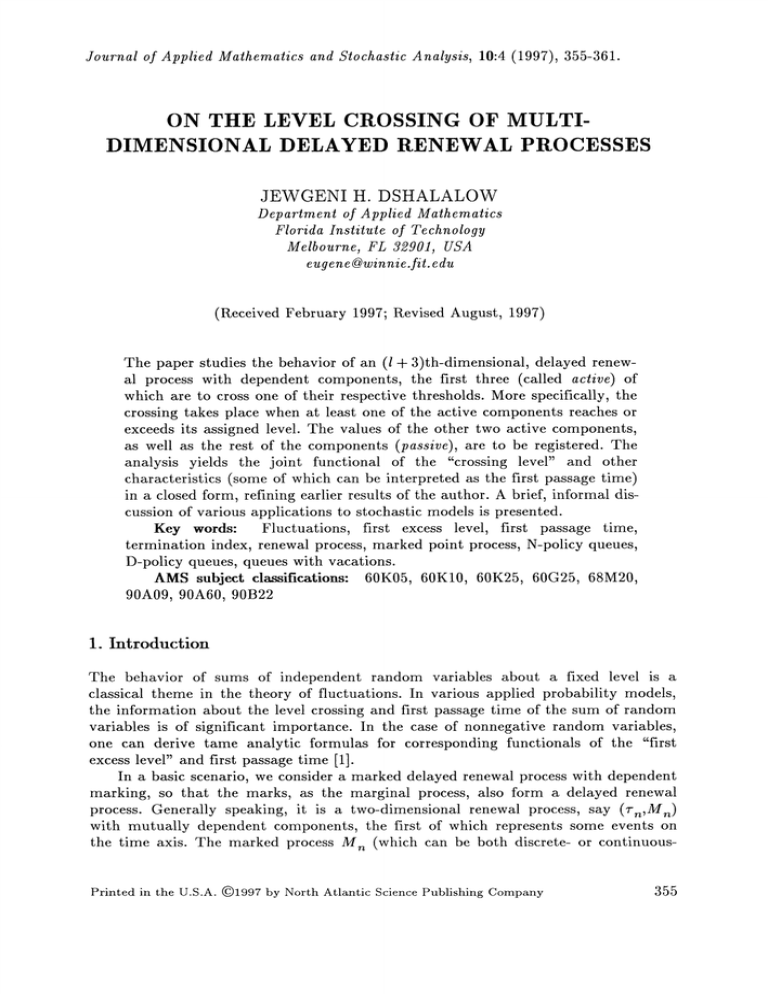
Journal
of Applied Mathematics
and Stochastic Analysis, 10:4
(1997), 355-361.
ON TtIE LEVEL CROSSING OF MULTIDIMENSIONAL DELAYED RENEWAL PROCESSES
JEWGENI H. DSHALALOW
Department of Applied Mathematics
Florida Institute
of Technology
Melbourne, FL 32901, USA
eugene@winnie.fit.edu
(Received February 1997; Revised August, 1997)
The paper studies the behavior of an (1 + 3)th-dimensional, delayed renewal process with dependent components, the first three (called active) of
which are to cross one of their respective thresholds. More specifically, the
crossing takes place when at least one of the active components reaches or
exceeds its assigned level. The values of the other two active components,
as well as the rest of the components (passive), are to be registered. The
analysis yields the joint functional of the "crossing level" and other
characteristics (some of which can be interpreted as the first passage time)
in a closed form, refining earlier results of the author. A brief, informal discussion of various applications to stochastic models is presented.
Key words: Fluctuations, first excess level, first passage time,
termination index, renewal process, marked point process, N-policy queues,
D-policy queues, queues with vacations.
AMS subject classifications: 60K05, 60K10, 60K25, 60G25, 68M20,
90A09, 90A60, 90B22
1. Introduction
The behavior of sums of independent random variables about a fixed level is a
classical theme in the theory of fluctuations. In various applied probability models,
the information about the level crossing and first passage time of the sum of random
variables is of significant importance. In the case of nonnegative random variables,
one can derive tame analytic formulas for corresponding functionals of the "first
excess level" and first passage time [1].
In a basic scenario, we consider a marked delayed renewal process with dependent
marking, so that the marks, as the marginal process, also form a delayed renewal
process. Generally speaking, it is a two-dimensional renewal process, say (rn,Mn)
with mutually dependent components, the first of which represents some events on
the time axis. The marked process M n (which can be both discrete- or continuousPrinted in the U.S.A.
@1997 by North Atlantic
Science Publishing Company
355
356
JEWGENI H. DSHALALOW
valued) evolves until it crosses a fixed, non-negative threshold upon one of the events
-n" Consequently, this component process is called active, while the other component
r n is passive.
A common application is queueing with N-policy and vacations
(see Heyman [8],
Lee et al. [9-1.1], Loris-Teghem [13-14], and Muh [15]). Here, when the system is exhausted, the server leaves on vacation, which includes a series of individual vacation
trips or segments. The server resumes his main work when, upon completion of one of
the vacation trips, the buffer accumulates to N or more units. (This policy is aimed
to reduce unwanted switchovers between busy and idle modes.) Another queueing
application is D-policy (see Balachandran and Tijms [2], Dshalalow [7],and Li and
Niu [12]). In this case, the idle or vacationing server gets back to service when the
accumulated work, in terms of the cumulative service time, hits a specified level D. A
combination of the two policies, suggested and studied in Dshalalow [5, 6], yielded yet
another practical application; the server would resume his primary work when the
number of units in the buffer or the cumulative work hit their respective levels,
whichever of the two comes first. This is associated with a three-dimensional renewal
process, say (-n,Qn,Wn), of which the first component is passive and the other two
(queue length and workload) are active.
Other applications may be found in the stock market. For example, this analysis
can predict the first fall of a stock from a bull spree (or visa versa), as well as its
level, by introducing an auxiliary process, whose increments are zeros or ones, dependent on whether or not the stock gained or lost in successive trades.
This paper deals with a further refinement of the studies initiated by the author
in [3,4]. It seemed reasonable to extend the number of active and passive components, and as it. turns out, the outgoing functionals of three active and a finitely
many passive components still yield compact formulas of a closed analytic form. The
stock market can make use of the results, especially in individual, diversified packages
or mutual funds dominated by two or three major stocks. Here it is worthwhile to
predict the first drop of any major components of the package. Inventories and
queueing may also find some practical applications of these results. For instance, we
may consider (batches of) units entering a servicing system along with their weights,
volumes, lengths, or energy. The service facility would stop vacationing when the
queue length, workload, or cumulative length of all units in the system crosses its
respective threshold, whichever comes first. This paper deals exclusively with the
derivation of formulas for the functionals of the values of a general (1 + 3)th-dimensional, delayed renewal process (with all dependent components) registered at the
moment one of the three active components crosses its assigned threshold. Applications, like those mentioned above, will follow.
2. Preliminaries
Suppose
m,’’’,rm; rn 0,1,...) is an (1 + 3)th-dimensional,
delayed renewal process defined on the probability space (f,at, P). In other words,
the vector increments %m lt, m_ 1 (Xrn,Yrn,Zrn Am,...,Am) rn 0,1,... (-J-I
0), are independent (although their components are not), and for rn >_ 1, identically
jointly distributed.
Without loss of generality, we assume that the first three components are
discrete, each valued in {0,1,...}, and the other are continuous, each valued in +.
On the Level Crossing of Multidimensional Delayed Renewal Processes
357
The joint distribution of the above increments is assumed to be given in terms of the
following functionals:
e[ XovVo Z%
where 0A0 is the scalar product of 0-
7(tt,V,W,0)
where 0A is the scalar product of 0-
(01,...,01)
and A0
(1)
--(A,...,A/0) T and
E[ttXlvYlwZle 0A1]
(01,...,01)
and A 1
(2)
--(AI,...,A) T
Given non-negative integers p,q, and r, define the random variable
u
min{u I -inf{i: A > p}, u 2 -inf{j: Bj > q}, u a -inf{k: C k > r}}
(3)
and call it the termination index. The process % will evolve until one of its first three
components, A, B, or C, called active components, crosses one of their respective
thresholds, p, q, or r. Consequently, the remaining components of % are referred to
as passive components. In summary, the process % will be terminated (passing u
"phases") once one of the active coInponents hits p, q, or r, whichever comes first.
The random vector %u is said to be the termination level, or alternatively, the first
excess level, although most likely only one of the three active components will exceed
p, q, or r.
Note that if one of the entries of T m (vlm,.. .,V/m) T, say Vm
,1 represents time,
then r 1u is referred to as the first passage time of %.
We will be interested in a closed form for the functional
E[uuAuvBuwCue Oru],
(4)
where 0- u is the scalar product of vectors 0 and r u.
For functions f: N o
N and g"
N, define the transformations
N03
Djf(w)-(1-w)j>oWJf(j)
and
wl < 1,
Dh, i, sg(X,Y, z) DhDiDsg(x,Y,Z)
The functions
f
(5)
(6)
and g can be restored through the inverse operator
k
lirnxO k! OxO k 1 1 x ("),
o,
]
0
(7)
used once:
(Dsf(x))- f(k ),
or
(8)
repeatedly, for instance:
(9)
Denote
JEWGENI H. DSHALALOW
358
Orv](x,y,z).
Theorem 1. The
(10)
functional ff satisfies the following expression:
1- -(,,,o)
7o(U,V,w,O) 70(ux, vy,wz,O) 1 7(ux, vy,wz,O)"
(11)
Proof. Obviously the events
H1 {//1 <//2 <//3),
H4 {2 < "3 < "1},
H7 {’ "2 < "3},
H2 {’1 < P3 < 2)’
H5 {"3 < "2 <
H8 {Pl P3 <
Ho {’ <
H {, <
H13 {1
"3},
2 3}
"
.
,
13
form a measurable partition of
Consequently,
where I H is the indicator function of set H and
i=1
AB
Set
A_
B_
C_
{//2 < //1 < //3}’
{//3 <//1 <//2},
{//2 =//3 < //1}’
{//3 <//1 =//2},
H3
H6
H9
"3}, HI2
IH
C
,
0.
From Dshalalow [4],
J
D(Z{, )(,) A_
D(Z{, })(y) yZ_ 1 yZ,
Ds(I {3 n})(z) zCn 1 zCn, n
1 and
-
O"IH)(x,y,z).
0,1,...,
0,1,...,
0,1,
13
i=I
i’
(12)
(13)
(14)
(15)
By Fubini’s theorem,
E
o
with
Rjk n
E
>
n
(16)
>
(17)
R ljR2jR3jkR4kRSknR6n
and
Il j
(tX) Aj_ l(vy)B j_ I(wz)Cj_ le
0-
3--1
(18)
(19)
R3j k
y Yj +
lzZ j +
I4k
Z
z k
15k n
z
1
...y YkZ
y Yk z k
Zk+l...z Z
I6n
lzZk- 1
1
Z
n-1
Zn
(20)
(21)
(22)
(23)
being independent, we arrive at
73(z
23(Y z).
710
+ 707
(24)
On the Level Crossing of Multidimensional Delayed Renewal Processes
359
where we denoted
7(,,v,wz,O), 70 0(,,z,e),
(,v,z,O),
o(,,z,O),
7a(z) 7(1,1,z,0), 723(Y,Z) 7(1,y,z,0),
(25)
()
()
/=
and
which are the corresponding functionals of the marginal processes.
Now,
2 can be obtained by interchanging the roles of v with w and y with z:
(y) 23(: z).
(28)
0 + 01
2 21-23(Y
,z) [
J’
72(y)
with
(29)
7(1,y,1,0).
Analogously,
(30)
(31)
(32)
(33)
with
o
(,v,z,O),
o(,v,z,O),
(,v,,o),
o(,v,,o),
7(X,1,1,0), ")’12(x,y) 7(x,y,l,0), /13(X,Z) 7(x,l,z,0).
")’l(X)
The next three 4i’s are as follows:
47
Dh, i,s-[kuAkvBkwCke-OrkI {"1
k>O n>k
and
(34)
()
()
that yields
(37)
where
-
,),12 ")’(tt,V,WZ,O), ,,2 ,O(t,V,WZ,O)"
Similarly,
48
where
and
49
where
70
")’0 -[-
")’103 3’ ")’03 + (7 + .)/13 .),1 ,3).)/0 1
,g3 7g
,
(38)
1
("
(39)
(40)
-t- (7 -t- 3/23
,,/2 73),),0 1
3"
(41)
JEWGENI H. DSHALALOW
360
-
(42)
The rest of 3 are subject to quite analogous calculations:
73(z) + 723(Y’ z)
)1 -723(Y;)-7
72(Y
1
10
1--
311
312
70
713(x,z){ 702
71(x) 73(z) +
1 713(x,z)
70?
72_7}
70 + 701 (7
(44)
1--71(x)1 - -712(x,z)72+712(x’z)"
(z) 730-70 --’)’0T_(7
(45)
1
(46)
+ (7123 -t- 71 -t- 72 -t- 73 712 713 723 7)70{ 1
where
(48)
’7
7’
,,/123 ")’(t,V,w,O) and 7 23 70(u,v,w,O).
The summation of 31 through 313 yields formula (11).
Now, the functional
E[{uuAuvBuwCue Oru]
E[{%Avw C e- 0f,]
can be restored
(47)
through
xz
p
r{
p q
7o(U,V,w,O) -[1 7(u, v,w,O)]2x2y
z
q
1
r
7o(Ux, vy,wz,O)
7(ux, vy,wz,O)
}
(48)
Analogously, we can also arrive at cases where all three active components of %
are continuous or mixed. In turn, all or some of the passive components of % can be
discrete. For instance, let the component C be continuous. Then substitute
w in
E[
uuAuvBu w us -Oru], 7 and 70 and
C
OO
C
D,f (s)
in place of D h. The function
operator
transform.
-Lapl-1((.)),
f
s
I,
e- 0
for
use the transformation
oe
sV
(49)
f (r]) dr]
by using the inverse Laplace-like
stands for the inverse of the Laplace
can be restored
where
Lap1-1
Given the third active component is continuous, we have the following result.
Theorem 2. The
3
functional
3(,u,v,e O,O;x,y,s)
Dh, iDo[
satisfies lhe following expression:
7o(,v,,o) 7o(,
,+
u Uv
B
ue -c Ue -o](,y, s)
,
1 7(u, v,,O)
,o) 1 7(,
+ ,o)"
(50)
(51)
The proof of this theorem is almost identical to that of Theorem 1. The formula
restoring the functional
E[uuAuvBuwCue Oru] is also very similar to (48)"
On the Level Crossing of Multidimensional Delayed Renewal Processes
361
(52)
References
[1]
Abolnikov, L. and Dshalalow, J.H., A first passage problem and its applications to the analysis of a class of stochastic models, J. Appl. Math. Stoch. Anal-
[2]
Balachandran, K.R. and Tijrns, H., On the D-policy for the M/G/1 queue,
Manag. Sci.,21:9 (1975), 1073-1076.
Dshalalow, J.H., On termination time processes, in Studies in Applied
Probability (ed. by J. Galambos and J. Gani, Essays in honor of Lajos
Takcs), J. Appl. Prob., Special Volume 31A (1994), 325-336.
Dshalalow, J.H., Excess level processes in queueing, in: Advances in Queueing
(ed. by J.H. Dshalalow), 243-262, CRC Press, Boca Raton, FL 1995.
Dshalalow, J.H., On applications of excess level processes to (N,D)-policy bulk
queueing systems, in Special Issue of Journ. Appl. Math. Stoch. Anal.
Dedicated to the Memory of Roland L. Dobrushin (ed. by J.H. Dshalalow), 9:4
ysis, 5:1
[3]
[4]
[]
(1996),
[6]
(1992),
83-98.
551-562.
DshalMow, J.H., Corrections: On applications of excess level processes to
(N,D)-policy bulk queueing systems, Journ. Appl. Math. Stoch. Anal., 10:2
(1997),
[7]
[8]
[9]
[10]
[11]
[12]
[13]
[14]
[15]
DshMMow, J.H., Queueing processes in bulk systems under D-policy, J. Appl.
Prob., (1998, to appear).
Heyman, D.P., Optimal operating policies for M/G/1 queueing systems, Oper.
Res. 16:2 (1968), 362-382.
Lee, H.W., Lee, S.S., and Chae, K.C., Operating characteristics of MX/G/1
queue with N-policy, Queueing Sys., 15 (1994), 387-399.
Lee, H.W., Lee, S.S., Park, J.O., and Chae, K.C., Analysis of MX/G/1 queue
with N-policy and multiple vacations, J. Appl. Prob., 31 (1994), 467-496.
Lee, H.W., Lee, S.S., and Chae, K.C., A fixed-size batch service queue with
vacations, J. Appl. Math. Stoch. Anal., 9:2 (1996), 205-219.
Li, J. and Niu, S-C., The waiting time distribution for the GI/G/1 queue
under D-policy, Prob. Engineer. Inform. Sci., 6 (1992), 287-308.
Loris-Teghem, J., Hysteretic control of an M/G/1 queueing system with two
service time distributions and removable server, in: Point Processes and
Queueing Problems, Colloquia Mathematica Societatis Jnos Bolyai, Hungary,
24 (1978), 291-305.
Loris-Teghem, J., Imbedded and non-imbedded stationary distributions in a
finite capacity queueing system with removable server, Cab. Centr. d’Etud.
Rech. Opr., 26:1-2 (1984), 87-94.
Muh, D.C.-R., A bulk queueing system under N-policy with bilevel service
delay discipline and start-up time, J. Appl. Math. Stoch. Anal., 6:4 (1993),
359-384.





